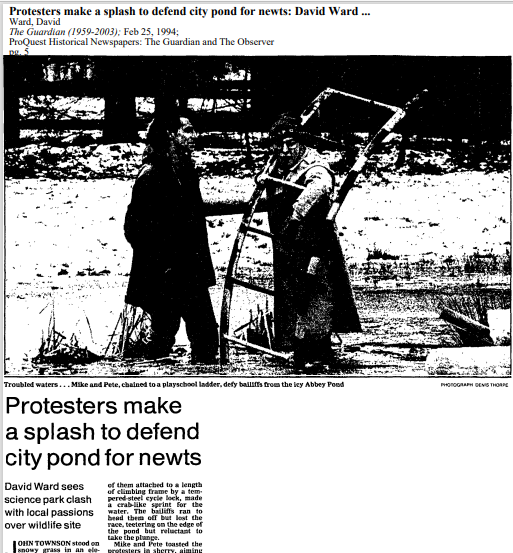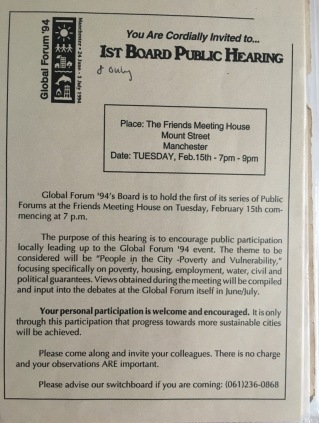also known as “The last post.” (Almost) every day from Friday 11th to Thursday 24th February, a post (sometimes two) will appear on this site, to celebrate the Republic of Newtonia – a brief occupation of a site in Hulme in defence of Abbey Pond (near the Old Abbey Taphouse). In 1994, local people and environmental activists tried to stop the Council and the Science Park from filling in the much-loved pond. If you were there, and want to share your memories (and any photos or other material) please do get in touch via mcmonthly@manchesterclimatemonthly or on Twitter – @mcr_climate
Also, on Thurs 24th, the 28th anniversary of the Pond’s destruction, there is an online meeting, from 7.30pm, bringing together people who were at the Republic of Newtonia with campaigners defending green spaces now. You can book here (it’s free).
The campers knew the day would come. On Thursday 24th February, the Republic of Newtonia ended, under the bulldozers of the Council. There’s more to be said and written about this (there was a good piece in the Guardian, for example) but for now, a written account (from Do or Die, the Earth First publication), and a portion of the interview with Unity Kelly.

Anyone reading the Guardian on Friday 25th of February would have been met with the bizarre photo on page 5 of two individuals standing knee deep in icy water in a pond in Hulme.
This pair were locked together through a length of gas pipe, and one of them (me), had a 12 foot piece of children’s climbing frame d-locked to his neck. Was this a bizarre form of aquatic auto-asphyxiation? Was it a new cure for smoking perhaps? In fact it was the latest in the increasingly long line of Direct Action taken by Manchester Earth First!.
For two weeks we camped out on and around Abbey Pond, one of the most ecologically diverse ponds, (shouldn’t that read ’only ponds’) in Greater Manchester and the only green space in a huge I960’s architectural abortion that is Hulme, an area near Manchester City Centre. We risked death in one of the most violent cities in England, and weather which fell to bellow minus ten, snow, hail and rain were thrown at us by the great global warmer. We were trying to stop the Science Park, (City Council. University of Manchester and UMIST are shareholders with fellow planet trashers Ciba-Geigy, Granada TV, Courtaulds and Ferranti), from building Phase Four- a laboratory, offices and huge car park to join the other one that has no cars in which was built during phase three.
The actions in the intervening two weeks ranged from the cuddly ‘Burst Main Event’, an alternative fair for kids, to a fax from David Bellamy, (never mind the RTZ sponsorship and the Ford cars commercial), to direct action when the bailiffs came on to the site to remove us. We had massive support from locals of all ages, although getting them to turn up and get into the way of the development was harder.
Local kids, more used to trashing cars than most eco-activists, ranted about too many car parks and how much they loved the only green space near their homes.
The site consisted of about 0.6 hectares with a small pond surrounded by 25 year old trees.
A tree house was built and hammocks hung, while we also built the ‘Wanstonia’- concrete bollards to lock arms through. There were 30 of us up at the site at 7.30 am and about the same number of police and bailiffs, but with outside agent provocateurs brought in from Lancaster, Liverpool and Leeds, we delayed trashing the pond by seven hours. Every trick in the book was used- D-Locking, tree sitting, pond sitting, obstruction and young children. But in the end most of our activists were arrested and while we remained imprisoned the pond had a small proportion of its waters removed by a tanker, while most wildlife understandably stayed near to the bottom where they were bull- dozed over with rubble. We plan more action.
Hyperactive Pete, Manchester Earth First!
And from Unity –
And there was this round metal disc, one of the things that the Earth Firsters had rescued, they must have used several shopping trolleys [to transport it to the site] it was the base of a children’s merry-go-round in Hulme. And we put it up on the frame.
And as the bulldozers were coming in, I walloped it symbolically with a piece of wood, and it must have resonated, it made ar bloody good noise, the knell of doom resonating all over Hulme, until people pleaded me to stop doing their heads in!.

